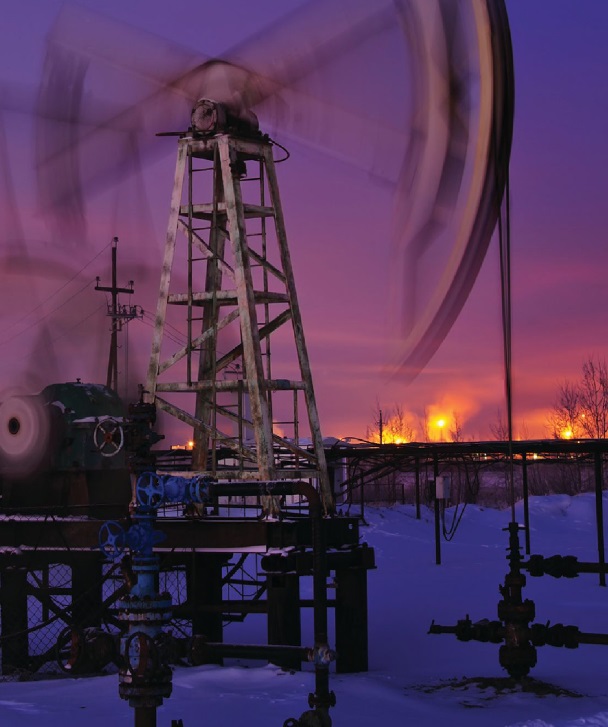‘Drill, baby, drill’
Dr. Robert M. Gresham, Contributing Editor | TLT Commentary January 2014
How the gasoline shortages of the 1970s set the course for today’s energy policies.

www.canstockphoto.com
KEY CONCEPTS
•
During the energy crisis nearly 40 years ago, many predicted the world would run out of crude oil by 1982.
•
Energy crises historically are caused not by natural market forces but by policies enacted by politicians globally.
•
Unlike the 1970s, oil production today comes from a wide group of supplies, including the North Sea, Alaska, Gulf of Mexico and deep water drilling.
“DRILL, BABY, DRILL!” WAS KIND OF A BATTLE CRY after the disruptions of the OPEC oil embargo of the 1970s. I know many of you were not even born then. However, this proud troglodyte was wallowing with his first job, first house, first mortgage, first rug rats crawling on the floor and major, major restrictions in the family budget.
The economy was not strong then, and my employer, DuPont in New Jersey, struggled to keep sales and earnings up and was advising us “not to make any major purchases” (which was code for you just might get laid off). Yet, there are lessons to be learned from history, and one of them is that as much as things change, in some ways they don’t change much at all.
History tells us that the OPEC embargo was prompted somewhat by U.S. military support for Israel, which was embroiled in the so-called Yom Kippur War. Arab exporters declared an embargo on shipments to western countries. Gasoline went from 33 cents to well over $1.20 a gallon—when you could get it. Lines at gas stations were common, and my family budget was in tatters. The blathering talking heads of the era claimed we were running out of crude oil and that OPEC was rationing a scarce resource. They also promised we would be out of crude oil by 1982. As usual, not true, but I suspect it sold a lot of newspapers and magazines, supported the efforts of some environmental groups and provided fodder for the late-night comedians.
Predictably, the political class, who through their policies helped to create the crisis, also tried to create policies to ameliorate it. As outlined in a recent article in the
Wall Street Journal, “Why OPEC No Longer Calls the Shots,” by Daniel Yergin, the “modern era of energy” was begun in the 1970s. Hence, “drill, baby, drill” resulted in new drilling in the North Sea and Alaska. Further, offshore drilling was greatly expanded, especially in the Gulf of Mexico. In addition, there was a push for nuclear power and coal to offset the oil shortage. To add to the delightful ironies of the political situation, some of my co-workers at DuPont used to listen to ship-to-shore radio traffic. They reported that there were numerous crude oil tankers anchored off the Jersey shore that were prohibited from entering port and emptying their cargos. Hmm, do you think politics were involved?
Finally, the government spawned the wind and solar industries with research funding and passed the first CAFE (corporate average fuel economy) standards to improve gas mileage in vehicles, which also spawned public and private research. Gas mileage was maybe as high as 13 mph (my car got 9 mph when well tuned) with the new standards mandating 27 mph some years in the future. The talking heads screamed for tiny cars (which opened the door for Japanese imports, further stressing domestic car producers), electric cars, bicycles, mass transit, more walking, roller skates, etc.— sound familiar? Many maintained that the high prices were due to gouging by evil corporations. In fact, the ruling class, on all political sides and in various countries, were at the bottom of much of the problem, with the marketplace simply responding to the disruptions they caused.
In France there was a big push to conserve energy waste, ultimately resulting with about 85 percent of its electric power coming from nuclear plants. Japan, always short on resources, likewise began a drive for energy efficiency. In the U.S., market forces caused a big push as well, which, of course, is not reported widely by the talking heads who thrive on strife.
According to Yergin, “Despite enormous growth in the U.S. economy since 1973, oil consumption is up less than 7 percent today.” However, the oil market has vastly changed. In 1973, most oil was consumed by the U.S., Japan and Western Europe. While oil consumption in these countries is essentially flat or falling, this decline has been offset by the so-called emerging economies of developing nations. They now consume half of the world’s oil. Indeed, China today imports more oil than the U.S. Today’s marketplace is a very different ballgame.
Though the political class doesn’t want to hear it, and the talking heads won’t say it, one lesson of the 1970s is the power of the markets to adjust to disruptions—if governments allow them to. Indeed, every time there is a disruption, the media rolls out images of the gas lines of the ’70s. In fact, however, most disruptions are caused by wars, regulations, price controls and allocations. Those aren’t true market forces, they are events caused by politicians.
The disruptions also included the natural-gas shortages of the ’70s. They also were caused primarily by price controls and regulation but at the time were considered, or perhaps sold, as being due to geology. Those regulations were relaxed, and now we have a “gas bubble.” Lo and behold!
As said before, the 1970s experience caused more exploration, drilling, coal and nuclear development and the creation of wind, solar and battery research and technology. Actually it was the combination of political and market forces working more or less together. It really was a crisis or that wouldn’t have happened.
As a result, we now see that the world’s production of crude oil production is 50 percent greater than in the 1970s but from more diverse sources: North Sea, Alaska, Gulf of Mexico, deep water drilling, Canadian oil shale and, most recently, the “tight oil” spinoff from oil shale, which has increased oil production in the U.S. by 50 percent since 2008. Further, according to Yergin, “U.S. imports are down to 35 percent of consumption—the same as it was in 1973.”
Research has led to early wind farms that still do not meet their design goals but are improving. Solar energy, while almost hopelessly subsidized, continues to improve. While the emerging electric and hybrid cars are not yet fully competitive, the technology is improving. These gains in energy security and efficiency affect global markets, not just in the U.S. market. Governmental regulation, as usual, remains a problem. Political disruptions remain at the core of our energy problems, as evidenced by the millions of barrels of oil not available due to the political issues affecting Iran, Iraq, South Sudan, Nigeria and Yemen. Thankfully, Saudi Arabia is producing at record levels. The harsh reality is that the world needs energy, lots of it, if society is to grow, thrive and provide for the well-being of its citizens.
So in the face of globally growing populations, emerging economies, adverse regulations, and political upheaval, the emphasis must be to continue to fund research into new and improved energy technologies.
And in the interim? Drill baby, drill!
 Bob Gresham is STLE’s director of professional development. You can reach him at rgresham@stle.org
Bob Gresham is STLE’s director of professional development. You can reach him at rgresham@stle.org.